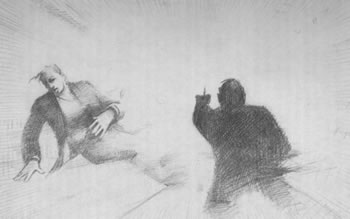St Woolos Cemetery - The Haunted Holy Ground
From the book "The Haunted Holy Ground" by Mike Buckingham and Richard Frame published in 1988.
The Fatal Flame
By Mike Buckingham and Richard Frame
First published 1988
© Mike Buckingham and Richard Frame 2012
In South Wales the idea of mines and death are inextricably linked: it would be strange were it otherwise.
But in the story we are about to relate the lives of no less than three miners were snuffed out like the light from Davy lamps when gas is present.
It was July, 1876 when the shaft of what was until recently Cwmcarn colliery was being sunk. Three men were among those employed in the sinking of the shaft. But although their work was to pave the way for thousands of Gwent miners of generations unknown to them, they were never to ascend into daylight again.
The circumstances of their awful death was as follows. On Monday, July 24 Thomas Jones, Henry Atkinson and William Williams had set some explosives with which to dislodge rock. Three charges were primed and fired and the three then gave the shaft half an hour to settle before dropping down to clear the debris.
The three were about to descend on the rudimentary lift but for some reason Atkins decided that he would go down with a naked flame despite the danger of explosive gas and company rules which expressly forbade such a lethal practice.
Jones, as it happened, had a safety lamp with him but this was not sufficient to save him from the folly of Atkins, who seemed not to understand that a major mine explosion can be sparked by the tiniest of unguarded lights.
Just before Atkins dropped down into what was to be his death he was warned that he should not take down a naked light, but with the nonchalance youth and inexperience can engender he shrugged off the warning.
That he did so was a tragedy.

drawing by David Pow
“As they got down to about sixty feet I saw a gas bubble appear and I shouted out to the winchman to stop,” said a witness. “The gas bubble exploded upon exposure to the candle. There was a blast in which Atkins and Jones were killed instantly, their bodies burned almost beyond recognition.”
Williams, it seems, grabbed at his two comrades not realising they were dead. The winchman hauled up the living miner and his sad cargo but not in time for the mine to have claimed its trinity of death.
Having been dragged from the very bowels of hell and made the surface, William expired within seconds of gasping out his request for a drop of water.
At the inquest held by W.H. Brewer, mentioned in the previous story, it was firmly concluded that the whole tragedy had been caused by the carelessness of Atkins.
More than a century afterwards there is a sequel to this story and here we can claim to have taken a hand.
We found the gravestone of Jones, standing upright, and perfectly decipherable once the ivy had been cleared away. The ivy had done the job of shielding the stone from the weather and had done its job so well that the original black paint that had been forced into the recessed lettering seemed fresh.
That was until the hurricanes which in October, 1987 lashed these shores.
In those storms the stone was felled and lays there still, face up. It is already weathering and within a few years the inscription will be illegible